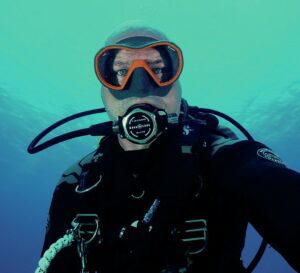There are many different varieties of sharks, and I love them all, but because we were recently lucky enough to meet one at the Burma banks. Here are 8 Interesting Tiger Sharks Facts.
How Big are Tiger Sharks?
While far behind the whale sharks, tiger sharks are still one of the largest shark species measuring 3 to 4 meters, for an average weight of 500kg! Usually found in temperate and tropical oceans, the tiger shark is typically a loner that hunts at night.

Are tiger sharks dangerous?
Do tiger sharks attack humans? Tiger sharks are indeed considered to be particularly aggressive because of its reputation for eating anything. However, accidents (and they are accidents, not attacks) with humans are rare.
Keep in mind though that shark bites, all species included, are very rare. There are less than 80 cases of shark bites per year worldwide, and less than 5 deaths per year worldwide because of a shark attack.
These accidents aren't attacks: they mostly occur on surfers or people attempting to feed them, which is not at all recommendable as that only encourage further problems. So as a recreational scuba diver I think we are pretty safe!

How did Tiger sharks get their name?
Tiger Sharks have a grey-brown body that is streaked with dark vertical stripes, similar to a tiger, hence the name. This is particularly visible in young adults, while juveniles have a silver-coloured livery that is spotted. As the shark reaches sexual maturaty, these stripes eventually disappear.

What makes the tiger shark such a great predator?
Like most sharks, the tiger shark has highly developed sensory organs, making them kinda a superhero, right?
– Lorenzini bulbs allow tiger sharks to detect electric fields as well as any vibration emitted by their prey
– tapetum lucidum, located at the bottom of the retina enables them, like cats, to amplify the light and see in the darkness.
All these sensory organs are adapted to its nocturnal hunting activity.

Where does the tiger shark live?
Tiger sharks are supposedly present in all tropical and subtropical seas. Still, it is mostly seen in the Caribbean, throughout the pacific and some times in the Indian Ocean (yeah !). Although not oceanic, they do undertake large crossings between the Islands.
Can tiger sharks live in freshwater? Absolutely not. Like most sharks species, tiger shark can only tolerate saltwater. The exception is the bull shark who can tolerate brackish water and have even been recorded cruising up large, warm, freshwater rivers, such as the Amazon.

What does the tiger shark eat?
Tiger sharks are often considered the dustbin of the seas, swallowing all sorts of things indiscriminately, including human trash, as found in the stomach of fished specimens: cans, plastic bags or even license plates. This lack of discernment is one of the reasons it can be dangerous. Because of its lack of selectivity, its predation activity includes many prey: other sharks, birds, sea snakes and even sometimes whales, especially if they are sick or injured.
How do tiger sharks hunt? The tiger shark is considered a super predator. When hunting, the tiger shark tends to swim slowly and accelerate abruptly when it is close enough to its prey.

How do tiger sharks reproduce?
Tiger sharks are the only ovoviviparous of the Carcharhinidae family. This means that the eggs incubate and eventually hatch into the mother's womb. His gestation period is close to 1 year, and the fertilised eggs remain in the belly of the female until hatching making them slow to reproduce. If a female is caught by fishermen the baby sharks will also perish. A female can carry up to 40 babies each, and they reach maturity at 4 years old.

Are tiger sharks endangered?
Like most sharks nowadays, tiger sharks are victim of fishing and bycatch. They are not yet endangered but the International Union for Conservation of Nature and Natural Resources (IUCN), identify them as a near-threatened species.

While a bit scary, this encounter was magical! And I do hope to see one again soon!
How about you?
Join us for a lifetime adventure diving Burma on MV Smiling Seahorse. Who knows what you're gonna see?
Written By Camille Fogarolo
Photos Credit: The Smiling Seahorse, Florida International University, ActiveWild.com
Want to read more blogs?








